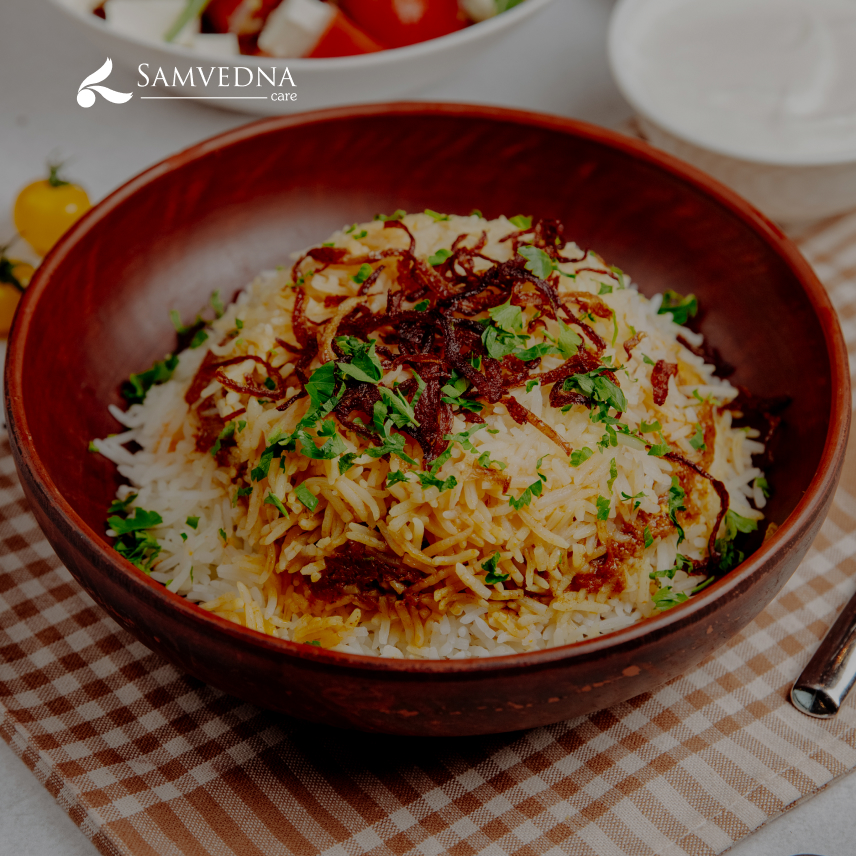Contact Us




When you open a pot of biryani, the first thing that hits you is the aroma, rich, warm, and inviting. But to truly taste it, you have to dig deeper. Beneath that top layer of golden rice lies hidden ingredients, spices, meat or vegetables, caramelized onions, each contributing to the dish’s complex flavor.
Our mental health works much the same way. What we show on the surface, a smile, a conversation, a routine day, often hides deeper emotional, psychological, and even biological layers. And just like a chef carefully stirs and steams each layer of biryani, mental health therapists at Samvedna Care help to explore, understand, and integrate the many layers of our inner world.
So, let’s lift the lid, layer by layer.
In a pot of biryani, the first thing you notice is the top layer of golden, fragrant rice. It looks beautiful, perfectly arranged, and often hides everything else beneath it.
This is our outer self, the layer of appearances, achievements, and social interactions. It’s the smile you put on even when you’re anxious, the “I’m fine” you say when you’re far from it.
In psychology, this is the mask of functioning, the version of ourselves that performs daily life. Many people with anxiety, depression, or trauma are what we call high functioning: they manage their responsibilities while quietly carrying deep emotional pain.
Mental health often suffers when this outer layer is all we tend to. We polish the rice for others to see but never stir what’s beneath. Over time, the dissonance between who we appear to be and how we actually feel creates emotional exhaustion. The first step toward healing is realizing that the top layer is never the full story.
Lift the rice, and you reach the masala, the heart of the biryani. It’s rich, flavorful, and intense. This layer holds the real personality of the dish, just as your emotions hold the real essence of your inner life.
Your emotional layer is where you experience joy, sadness, anger, fear, excitement, guilt all the shades of human feeling. But in many of us, this layer becomes overcrowded or uneven. Some emotions are overcooked (like chronic anger or anxiety), while others are undercooked, never expressed, never processed.
From a psychological perspective, emotional imbalance often arises from emotional invalidation, when, growing up, we were told to “stop crying,” “be strong,” or “don’t overreact.” Over time, we learn to distrust our own emotions and suppress them. The result is like a biryani where the masala is hidden under too much rice: the dish looks fine, but the taste feels flat and unsatisfying.
Healing starts with emotional awareness, the ability to name what you feel without judgment. When you allow emotions to exist, you give them space to settle rather than spill.
At the bottom of the pot lies the heaviest, slowest-cooking layer, the meat or vegetables that carry the dish’s true depth. This layer soaks up every spice, every aroma, and gives meaning to the entire meal.
Psychologically, this layer represents your core beliefs and formative experiences, the childhood patterns, attachment styles, and subconscious narratives that shape how you see yourself and the world.
If, as a child, you felt unloved, unseen, or unsafe, you may have absorbed beliefs like “I’m not worthy,” or “People will leave me.” These beliefs simmer quietly beneath the surface and influence your adult relationships, self-esteem, and coping mechanisms.
In therapy, mental health therapists often work to uncover and “re-cook” these deeper layers helping people rewrite outdated scripts and create more balanced internal narratives. Because just like biryani, if the bottom layer burns or remains raw, the whole dish is affected.
Now comes the invisible ingredient: steam. You don’t see it, but without it, the biryani would never come together. The steam allows every layer to blend, soften, and harmonize.
This is the process of therapy, self-reflection, and emotional integration. Healing isn’t about removing difficult emotions, t’s about sitting in the “heat” long enough for transformation to occur.
In therapy, the sealed pot represents the safe space, confidential, contained, and warm enough to let things surface without judgment. You begin to stir your own layers, taste them, and adjust them. Over time, you notice that what once felt fragmented starts to feel more whole.
The key here is patience. Healing, like dum biryani, cannot be rushed. The best results come from low flame and steady warmth, small, consistent acts of care that build resilience over time.
When all the layers are cooked well and come together, you get something aromatic, balanced, and deeply satisfying. The same is true for the mind.
Mental health isn’t the absence of problems; it’s the harmony between your visible self, emotional self, and core self. It’s when your thoughts, feelings, and actions align, not perfectly, but authentically.
So, What’s Your First Layer?
Maybe it’s acknowledging that you haven’t been feeling quite like yourself lately. Or maybe it’s simply realizing that no amount of productivity hacks can replace genuine emotional understanding.
Whatever your first step looks like, take it. Don’t stop at the surface. Peel back the layers, gently and patiently. Healing takes time, presence, and care.
Because just like a truly good biryani, your mental well-being isn’t about speed, it’s about depth, balance, and the art of giving each layer the attention it deserves. At Samvedna Care, our mental health therapists walk with you through every layer, helping you uncover, understand, and nurture your mental health, one mindful step at a time.